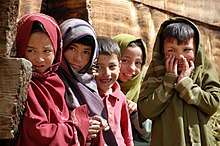Balti people
 Balti children of Tarashing | |
| Total population | |
|---|---|
| 28% of Gilgit-Baltisan (247,520) (1998) | |
| Regions with significant populations | |
|
Gilgit–Baltistan (Pakistan) Ladakh (India) | |
| Languages | |
| Balti | |
| Religion | |
| Shia Islam majority,[1] minorities of Sufia Nurbakhshia, Sunni Islam, Tibetan Buddhism and Bon. | |
| Related ethnic groups | |
| Burig, Ladakhis, Tibetans, Dards |
The Balti are an ethnic group of Tibetan descent with Dardic admixture who live in the Gilgit–Baltistan region of Pakistan and the Kargil region of India. Smaller populations are found in the Leh region; others are scattered in Pakistan's major urban centres of Lahore, Karachi and Islamabad/Rawalpindi.
Language
The Balti language belongs to the Tibetic language family. Read (1934) considers it a dialect of Ladakhi,[2] while Tournadre (2005) considers it a sister language of Ladakhi.[3]
Religion
The Baltis historically practiced Bön and Tibetan Buddhism. Islam arrived in Baltistan via Sufi missionaries such as Ameer Kabeer Syed Ali Hamadani in the 15th century, and soon became dominant. The Baltis still retain many traits of pre-Islamic Bön and Lamaist rituals, making them unique in Pakistan.[4] The swastika (Yung drung) sign is considered auspicious and is carved on wooden planks that can be seen in historical mosques and Khanqahs. Showing respect to Lha and Lhu (Bön gods) is customary during many village rituals.
Baltis regard congregation in the mosques and Khanqahs as an important religious ritual. The Khanqahs are training schools which were introduced by early saints who arrived in the region. The students gain spiritual purity (tazkiah) through these trainings (meditations and contemplations) under well-practiced spiritual guides, who have already attained certain degree of spirituality.
Mosques in Baltistan are mainly built in the Tibetan style, though several mosques constructed have wood-finish and decorations of Mughal origin which can also be seen in Ladakh, Kargil. On every Friday, the men generally attend the Friday prayers sometime after noon. All Muslims will fast by day during the month of the Ramadan, and a celebration will be held at the end of the celebration.
Today, the Baltis are 60% Shi'a, 30% Sufia Imamia Nurbakhshia, and 10% Sunni.[5]
Small pockets of Bön and Tibetan Buddhist believers in Kharmang Valley and West Kargil amount to about 3000 people.[6]
See also
- Tibetan Muslims
- Three Cups of Tea, a book about an American who was involved in building schools in Baltistan
- Sart
- Balti language
- Gilgit-Baltistan
References
- ↑ Bakshi, S.R. (1997). Kashmir: History and People. Sarup & Sons. p. 186. ISBN 978-81-85431-96-3.
- ↑ Balti Grammar, by A. F. C. Read. London: The Royal Asiatic society, 1934.
- ↑
- ↑ "The Nurbakhshi religion in Baltistan". Baltistan Foundation. Retrieved 7 March 2018.
- ↑ Bakshi, S. R. (1997-01-01). Kashmir: History and People. Sarup & Sons. ISBN 9788185431963.
- ↑ "Archived copy". Archived from the original on 2007-09-28. Retrieved 2006-06-12.
Further reading
- Muhammad Yousuf Hussainabadi, 'Baltistan per aik Nazar'. 1984.
- Hussainabadi, Mohamad Yusuf. Balti Zaban. 1990.
- Muhammad Yousuf Hussainabadi, 'Tareekh-e-Baltistan'. 2003.
- Addition of new four letter to tibetan scripts by Yusuf Hussainabadi Indian Muslim.
- Akhond Muhammad Hussain Kashif "Malumaat e Gilgit Baltistan" 2013.
- Shumal kay Sitarey by Ehsan Ali Danish Sermik.
- Azadi e Gilgit Baltistan by Muhammad Yousuf.